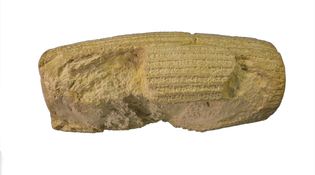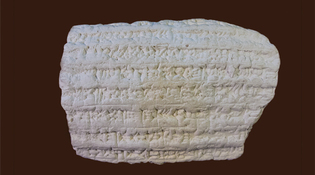 loading
loading
Arts & CultureA piece of the puzzleObject lesson William W. Hallo is the William M. Laffan Professor Emeritus of Assyriology and Babylonian Literature.  Courtesy Sterling Memorial Library. Photo: Mark Zurolo ’01MFAView full image Courtesy Sterling Memorial Library. Photo: Mark Zurolo ’01MFAThe Cyrus Cylinder is a monument from ancient Persia now in the British Museum. A fragment of the nearly nine-inch-long cylinder was found in Yale's Babylonian Collection. The photos above show two casts in Yale's collection: the complete cylinder, with fragment in place, is at top; the fragment itself is just above. Yale's fragment gives details of building operations at Babylon. View full imageWhat Yale collection, renowned among scholars of antiquity worldwide, is virtually unknown to all Yale students except the select few who were smart enough to take a course or a work-study job there? Answer: the Yale Babylonian Collection, housed in Sterling Memorial Library. The collection includes some 40,000 manuscripts, mostly in the form of clay tablets inscribed in cuneiform, arguably the world’s first writing system. Of course, after 40 years (1962–2002) as the collection’s curator, I have my favorites. At the top of the list: Yale’s piece of the Cyrus Cylinder. You may have heard of the famous Cyrus Cylinder making its way through a succession of US museums in 2013, courtesy of the British Museum in London, where it is normally housed. Sometimes described as the Magna Carta of antiquity, this cuneiform monument dates from the sixth century BCE. It authorizes the return of exiles to their ancestral lands—a magnanimous decree of the Persian emperor, Cyrus the Great, who thus reversed the deportation policies of his Babylonian and Assyrian predecessors. The inscription has been seen by some historians as corroboration that Cyrus repatriated the Jews, as described in the Bible, in the Book of Ezra. It would have been 50 years after their expulsion by Nebuchadnezzar II. What is less often noted is that significant portions of the cylinder were missing when it was found in 1879 in the ruins of Babylon, part of what today is Iraq. One of those gaps was filled a few decades ago, in 1975, by a young German Assyriologist who theorized that a fragment described years before would fit exactly. That fragment has been in the Yale Babylonian Collection since the early 1900s, when it arrived as part of the bequest of an alumnus—though how he acquired it remains a mystery. To confirm the Assyriologist’s theory, we had to join the Yale fragment physically to the British Museum’s cylinder. Fortunately, I was in Oxford at the time, on sabbatical, so I was able to oblige my British colleague (after some suspenseful waiting for the shipment). It was a perfect fit. Today, the fragment is displayed in its proper place as part of the Cyrus Cylinder in the British Museum, though technically it remains a part of Yale’s Babylonian Collection. A copy is in Sterling Library. Meanwhile, Iran regards the cylinder as part of its own history. In 1971, the then-shah of Iran borrowed the cylinder as a symbol of Iran’s monarchy. When the cylinder spent four months on loan to Tehran in 2010, the Iranian president at the time, Mahmoud Ahmadinejad, described Cyrus reverentially as “King of the World.” Hardliners in 2010 threatened not to return the cylinder to the British, but cultural diplomacy won out.
|
|
3 comments
-

Roxanne Khazarian, 1:46pm October 31 2014 |  Flag as inappropriate
Flag as inappropriate
-

Stephanie Wald , 12:24pm November 01 2014 |  Flag as inappropriate
Flag as inappropriate
-

Aspy Minoo Khan, 12:53pm November 01 2014 |  Flag as inappropriate
Flag as inappropriate
The comment period has expired.Darn wish I knew when I was at school and my ancestry traces from there too!!!!!!
luckily it was returned to the British museum as its future in Iran might have been lost again.
I'am glad too that it was returned to the British museum, considering that Islamist have developed a penchant for blowing up things if some jerk perceives it to be some sort of an idol.
Remember the 'Bamian Buddhas' dynamited by the Taliban, on sheer whim.
An unforgivable wanton destruction of priceless treasure.